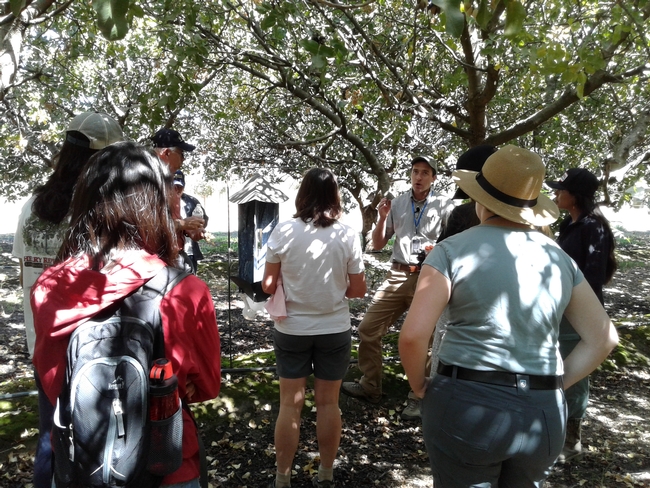Posts Tagged: plant pathology
UC Riverside graduate students broaden their education at Kearney.
Under the auspices of Georgios Vidalakis, Professor at UC Riverside, a handful of graduate students visited Kearney to broaden their scientific knowledge and see examples of how individuals in careers such as their own can have an impact. The students were from a variety of disciplines including Plant Pathology, Microbiology, Entomology, and Botany. Vidalakis said that one reason he chooses to make the annual trek to Kearney is the great diversity of agriculture represented in this one field station.
Their morning was spent in the field.
Nematologist Andreas Westphal explained how he is saving years of research time by testing walnut rootstock against nematodes and for compatibility with commercial scion wood, simultaneously. Below.
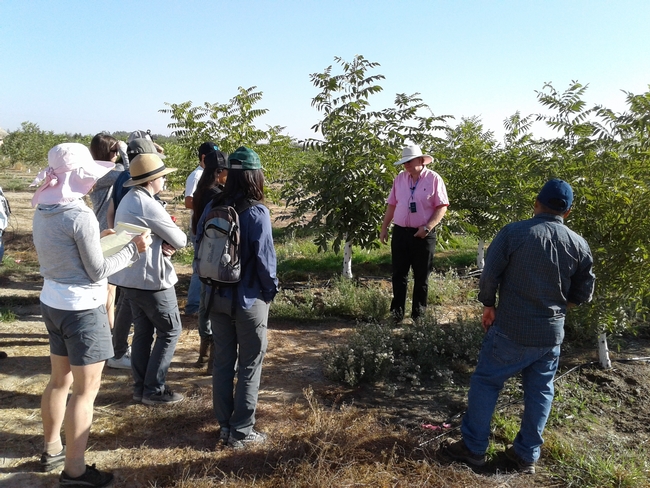
Themis Michailides, Plant Pathologist, showed the students samples of infected pistachios. Later he said of this, “The disease is anthracnose of pistachio caused by Colletotrichum fioriniae, according to Project Scientist, Paulo Lichtemberg. It is a new disease in California and caused major problem in a few orchards in Glenn Co. The same disease in 2010 destroyed 75% of the Australian pistachio crop. It is fortunate that the Kerman pistachio that is extensively planted in California shows more tolerance to this pathogen than the susceptible Red Aleppo cultivar. At present, we (with the lead of Paulo Lichtemberg) are doing epidemiological studies to determine conditions affecting the disease, evaluation of pistachio cultivar susceptibility to the pathogen, and fungicide trials to manage it.” Below.
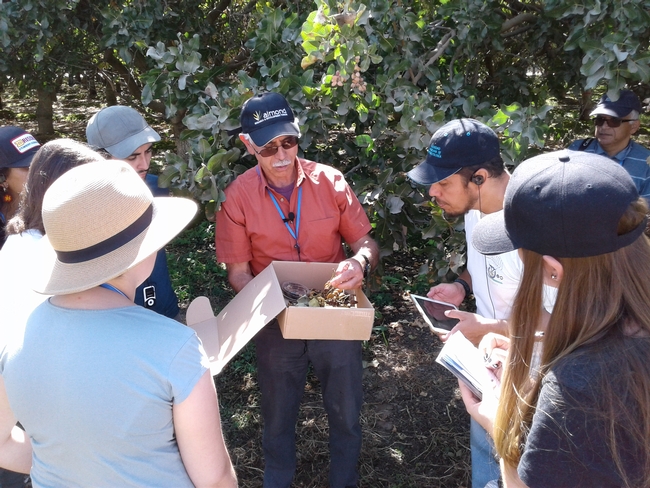
The students examined a novel trapping method for leaffooted bug as Entomologist Houston Wilson related control strategies for this emerging pest of pistachios. Below.
After lunch, Leslie Holland, a Plant Pathology PhD Candidate working with CE Specialist Florent Trouillas, gave a presentation to students on the important role of plant disease diagnosis to growers and to research institutions. Holland spoke with students about emerging diseases in the fruit and nut crop industry in California and the research being conducted to manage these diseases.
The group continued their day learning from Director Jeff Dahlberg how he and just six other people on the board of the Whole Grains Counsel developed the Whole Grains Stamp. The stamp, used to help consumers make healthy eating choices, is now on 12,000 different products in 58 countries. Vidalakis said that for the students to see firsthand the kind of influence a small group can have in the world was a “jaw-dropping” moment.
The Enemy of the Gardener
Aphids, don't you just hate them? Especially those oleander aphids that suck the very lifeblood...
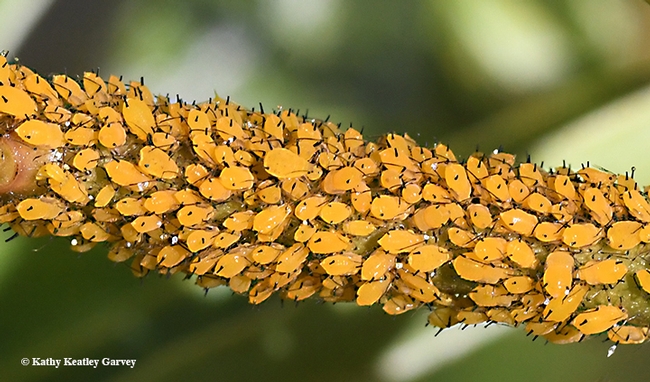
Oleander aphids clustering on a milkweed stem. (Photo by Kathy Keatley Garvey)
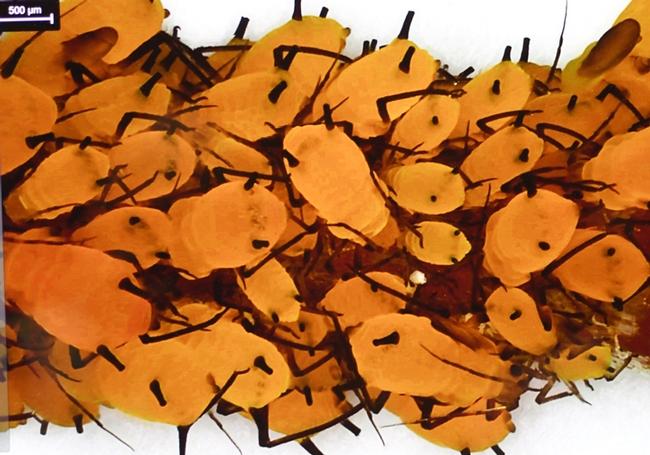
Aphids magnified on a Leica DVM6 microscope, operated by Lynn Epstein, UC Davis emeritus professor of plant pathology.
UCD plant pathology graduate students visited Kearney on May 13, 2016 to have classes in the field.
UCD plant pathology graduate students visited Kearney on May 13, 2016 to have classes in the field.
Bob Gilbertson, professor in the Department of Plant Pathology at UC Davis, specializing in seed pathology, virology, and insect-transmitted viruses, brought 18 graduate students to the University of California Agriculture and Natural Resources Kearney Agricultural Research and Extension Center (UC ANR KARE) in May. The visit was related to the course: PLP 205A Diseases of Field, Vegetable, Fruit and Nut Crops.
The field trip started with a general introduction about the UC Extension principles and philosophy by Pete Goodell, UC Cooperative Extension advisor, Statewide Integrated Pest Management Program and UC ANR KARE. Students then got a field tour lead by Chuck Boldwyn, Center Superintendent of Agriculture at UC ANR KARE and field presentations by Florent Trouillas, Assistant UC Cooperative Extension specialist in the Department of Plant Pathology at UC Davis and UC ANR KARE, Themis Michailides, Plant Pathologist in the Department of Plant Pathology at UC Davis and UC ANR KARE, and George Zhuang, UC Cooperative Extension advisor in Fresno county, specializing in viticulture and enology, on various diseases and related issues.
Field presentations included:
- Prunes: wood decay and Cytospora canker
- Pistachios: Botryosphaeria shoot and panicle blight; bushy top syndrome, and research on Aflatoxin
- Grapes: grapevine canker diseases (Esca, Phomopsis, Eutypa and Botryosphaeria).
Kearney hosted a workshop on leaffooted bug monitoring, damage to tree nut crops, and management strategies.
On May 10, 2016, Kearney researchers, Kris Tollerup, UC ANR cooperative extension advisor at Kearney Agricultural Research and Extension Center, specializing in Integrated Pest Management (IPM) for almond, pistachio, tree fruit and grape crops; and Themis Michailides, UC ANR plant pathologist and lecturer in Plant Pathology at UC Davis and Kearney Agricultural Research & Extension Center, conducted a workshop to help attendees learn more about leaffooted bug monitoring, damage, management, and its involvement in spreading Bot of pistachio and other diseases on pistachio and almond.
Tollerup discussed the different Hemipteran pests (leaffooted bugs and stink bugs). A PowerPoint handout was provided. The handout covered what the bugs look like; the stages of the bugs' growth; diagnostics for identification; the host crops; overwintering, what the damage to almonds and pistachios looks like; when the damage occurs; what we know, and what we need to know.
In the field, Michailides showed how the insect damage can lead to an increased incidence of pathogenic infections. Field research by Michailides and Dave Morgan has shown that there is an “association of Botryosphaeria panicle and shoot blight of pistachio with injuries of fruit caused by Hemiptera insects and birds.”
Michailides concluded that the disease in almonds caused by insect damage “is a new disease of almond and it is very similar to the stigmatomycosis reported on pistachio.” Early insect damage can result in the nuts dropping from the tree and later damage can render part of the crop unmarketable due to decay and black spots on the kernels.
The photograph shows: Infection of pistachio fruit by Neofusicoccum mediterraneum (initially identified as Botryosphaeria dothidea, thus the name Bot of pistachio disease) initiated from insect-punctured fruit and spread into the main rachis of the cluster [A and B; note a leaffooted bug (Leptoglossus clypealis) on the rachis of pistachio cluster in B]; C, fruit infected by the pathogen and covered with pycnidia surrounding the sap exuded from the insect's injury; D, fruit infections initiated from injuries caused by birds and spread into the main rachis of clusters.
LREC Plant Pathology Lab Receives and Passes CDFA Compliance Inspection
Over the past year and a half, UCCE Tulare County Farm Advisor Elizabeth Fichtner and...

Sabrine Dhaouadi (left), visiting scientist, and Elizabeth Fichtner, UCCE Tulare farm advisor (right) introduce Stephanie Theodore (center) to the new pathology facility at LREC.
